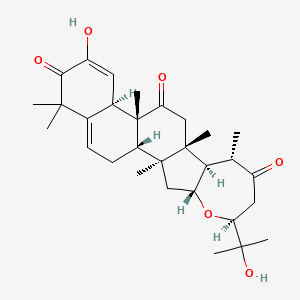| Authors | Title | Published | Journal | PubMed Link |
|---|---|---|---|---|
| Boykin C et al. | Cucurbitacin IIa: a novel class of anti-cancer drug inducing non-reversible actin aggregation and inhibiting survivin independent of JAK2/STAT3 phosphorylation. | 2011 | Br. J. Cancer | pmid:21304528 |
| Pedersen AB and Godfrey LD | Evaluation of cucurbitacin-based gustatory stimulant to facilitate cucumber beetle (Coleoptera: Chrysomelidae) management with foliar insecticides in melons. | 2011 | J. Econ. Entomol. | pmid:21882695 |
| Lee DH et al. | Cucurbitacin: ancient compound shedding new light on cancer treatment. | 2010 | ScientificWorldJournal | pmid:20209387 |
| Patel SK et al. | Prediction of the solubility of cucurbitacin drugs in self-associating poly(ethylene oxide)-b-poly(alpha-benzyl carboxylate epsilon-caprolactone) block copolymer with different tacticities using molecular dynamics simulation. | 2010 | Biomaterials | pmid:19796808 |
| Patel SK et al. | Molecular dynamics study of the encapsulation capability of a PCL-PEO based block copolymer for hydrophobic drugs with different spatial distributions of hydrogen bond donors and acceptors. | 2010 | Biomaterials | pmid:19962756 |
| Ramalhete C et al. | New potent P-glycoprotein modulators with the cucurbitane scaffold and their synergistic interaction with doxorubicin on resistant cancer cells. | 2009 | Bioorg. Med. Chem. | pmid:19733087 |
| Patel SK et al. | Roles of nonpolar and polar intermolecular interactions in the improvement of the drug loading capacity of PEO-b-PCL with increasing PCL content for two hydrophobic Cucurbitacin drugs. | 2009 | Biomacromolecules | pmid:19655789 |
| Abou-Khalil R et al. | Interaction of cucurbitacins with human serum albumin: Thermodynamic characteristics and influence on the binding of site specific ligands. | 2009 | J. Photochem. Photobiol. B, Biol. | pmid:19380237 |
| Maloney KN et al. | Actin-aggregating cucurbitacins from Physocarpus capitatus. | 2008 | J. Nat. Prod. | pmid:18959442 |
| Chen J et al. | Trinorcucurbitane and cucurbitane triterpenoids from the roots of Momordica charantia. | 2008 | Phytochemistry | pmid:18045630 |
Cucurbitacin S
Cucurbitacin s is a lipid of Sterol Lipids (ST) class. The involved functions are known as establishment and maintenance of localization and nitric oxide biosynthetic process.
Cross Reference
Introduction
To understand associated biological information of Cucurbitacin S, we collected biological information of abnormalities, associated pathways, cellular/molecular locations, biological functions, related genes/proteins, lipids and common seen animal/experimental models with organized paragraphs from literatures.
What diseases are associated with Cucurbitacin S?
There are no associated biomedical information in the current reference collection.
No disease MeSH terms mapped to the current reference collection.
PubChem Associated disorders and diseases
What pathways are associated with Cucurbitacin S
There are no associated biomedical information in the current reference collection.
PubChem Biomolecular Interactions and Pathways
Link to PubChem Biomolecular Interactions and PathwaysWhat cellular locations are associated with Cucurbitacin S?
There are no associated biomedical information in the current reference collection.
What functions are associated with Cucurbitacin S?
Related references are published most in these journals:
| Function | Cross reference | Weighted score | Related literatures |
|---|
What lipids are associated with Cucurbitacin S?
There are no associated biomedical information in the current reference collection.
What genes are associated with Cucurbitacin S?
There are no associated biomedical information in the current reference collection.
What common seen animal models are associated with Cucurbitacin S?
There are no associated biomedical information in the current reference collection.
